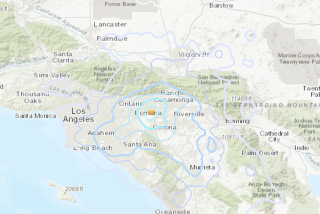Something’s Up Underneath Idaho
CASCADE, Idaho — These days, when Linda Jarvis gets home from work, she heads to the garage to check the seismograph readings that scroll across a laptop computer propped on a workbench.
Life’s been more interesting than usual since an earthquake cluster, or swarm, set the cupboard doors swinging at Jarvis’ house in September. The swarm has waxed and waned since then, but it’s still knocking bricks out of her chimney and snaking cracks across her garage floor.
Now Jarvis, a special education teacher, is letting a Boise State University seismologist use her garage for a monitoring station. She can see the earthquake activity on a screen even as she feels it.
“It was a good experience to actually see it on the screen,” said Jarvis, whose home about 50 miles north of Boise is sitting in one of the nation’s most active earthquake zones.
Swarms of minor quakes are not unknown in Idaho. The last one was in Donnelly in 2001. But some things about the Cascade-area swarm are unusual, said Jim Zollweg, the BSU seismologist who set up his instruments in Jarvis’ garage.
For one thing, Jarvis and neighbors in her rural community of Clear Creek can feel the tremors -- which is uncommon for Idaho swarms. Clear Creek residents are regularly awakened by late-night rattling, sometimes strong enough to knock cups off counters. The swarm has cracked Jarvis’ garage floor, shifted one wall a few inches and left a pile of brick shards around the base of her chimney.
Jarvis was gardening last weekend when she decided to check the seismograph readings in her garage. As she watched the computer screen, the straight lines started to jump and show intense activity -- signs that a tremor was underway. Then she heard the hanging tools around her start to bang against the walls.
Another unusual aspect of the swarm is that, although the number of larger quakes has dropped since September, the smaller ones are still going strong, said Zollweg. He measures 300 to 1,000 tremors a day in the area of the Long Valley fault, where Jarvis lives.
The largest tremor so far has been magnitude 3.7. Earthquakes of that size usually aren’t felt, but Zollweg thinks the Long Valley quakes must be closer than normal to the surface.
Using a grant from the Idaho Geological Survey, Zollweg has set up six seismographs around the Long Valley region to learn more about the swarm. Earthquake prediction is a tricky business, but Zollweg thinks that the more he knows about Idaho’s seismic activity, the more he’ll be able to judge when and if a big one is on its way.
“What I’m doing at Long Valley is ... kind of forecasting,” he said. “I’m saying because we have the swarm, and because of its unusual characteristics, we have a higher-than-normal chance of a larger earthquake occurring.”
The Geological Survey, at the University of Idaho in Moscow, said the state ranked fifth in the nation in earthquake risk, behind California, Nevada, Utah and Alaska.
Idaho has felt two large earthquakes in recent memory; both caused deaths and millions of dollars in damage. One was the 1959 Hebgen Lake earthquake in Montana, a magnitude 7.1; the other was the 1983 Borah Peak earthquake, a magnitude 7.
It’s not known if the swarm around the Long Valley fault is connected to that fault, or to more than one underground feature. In fact, little is known.
Unlike its earthquake-prone neighbors, Idaho has no central point of contact for earthquake research, said Stephen Weiser, manager of plans and mitigation programs for the Idaho Bureau of Homeland Security.
“If we did have a robust seismic network in the state with a number of stations, we could have a good warning system, and scientists could better understand the nature of earthquakes in the state,” Weiser said.
Zollweg said Idaho’s seismic risks hadn’t been studied as much as those in California, Washington or Oregon.
Jarvis, who has lived in her wood-frame home 19 years, has tried unsuccessfully to buy earthquake insurance. A light sleeper, she stayed at a friend’s house once to get a full night’s rest. But she has no plans to move, and she doesn’t think her life is in danger. “I’m thinking positive,” she said.
More to Read
Sign up for Essential California
The most important California stories and recommendations in your inbox every morning.
You may occasionally receive promotional content from the Los Angeles Times.










